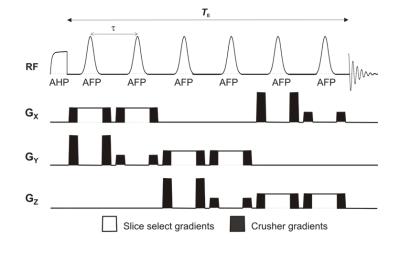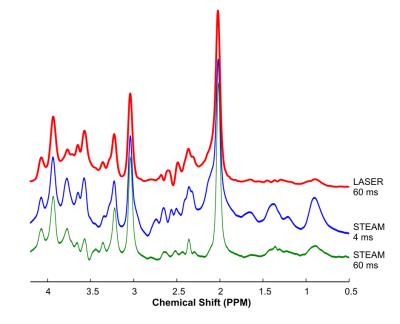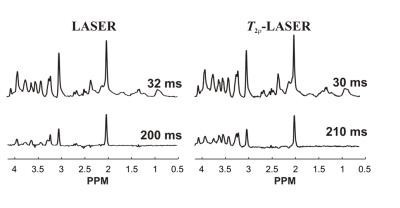5585
Properties of Localization by Adiabatic SElective Refocusing (LASER) sequence1CMRR, University of Minnesota, Minneapolis, MN, United States
Synopsis
This abstract reviews and highlights the various properties and advantages of the LASER pulse sequence
Purpose
To review and highlight properties and advantages of the LASER sequenceProperties of LASER sequence
1. Fully adiabatic single-scan 3D localization
2. No need for outer volume suppression (OVS)
The LASER sequence1 consists of a nonselective adiabatic half-passage (AHP) pulse followed by three pairs of gradient selective adiabatic full-passage (AFP) pulses of the HSn family (Figure 1). The echo time (TE) is defined as the total time from the end of the AHP pulse to the start of signal acquisition. At 9.4 T on pre-clinical scanner, a typical LASER sequence using a 4 ms AHP pulse and 1.5 ms AFP pulses (HS1 R25) results in a minimum TE of 18 ms. At 3 T, on Siemens scanner using gradient-modulated refocusing pulse like GOIA2, LASER can be executed with a minimum TE of 35 ms.
3. Well defined localization: minimal chemical shift displacement and sharp and clean profiles
Due to properties of the AFP pulses, clean profiles with sharp transition are obtained (Figure 2). The chemical shift displacement (CSD) error is minimal in LASER due to the large bandwidth of the AFP pulses which are typically 10 kHz or higher (Table 1). At 9.4 T on pre-clinical scanner, the CSD error is relatively small (2.4%/ppm). On human scanner with 3.2 ms GOIA pulses, the CSD error is negligible. However, off-resonance small smearing artifacts exist.
4. Suppression of J-evolution
The successive application of multiple AFP pulses in LASER acts as a Carr-Purcell pulse train3 such that the J-coupling evolution in J-coupled metabolites is minimized. This occurs when the time evolution due to J-modulation becomes negligible, i.e. when $$τ √δ^2+J^2 << 1$$ where τ is an interpulse delay, J is the coupling constant and δ is the chemical shift difference between coupled spins. This effect is shown Figure 3 where the spectral patterns of coupled metabolites like glutamate, glutamine, myo-inositol are still preserved with LASER at 60 ms compared to STEAM at a similar TE and are comparable to short-TE STEAM spectrum4. By adding train of AFP pulses without any delay between the AHP and the first gradient-selective AFP pulse, sequence called T2p-LASER5, J-modulation can be further preserved especially at long TE. For instance, data from 9.4 T show that the multiplets of taurine and myo-inositol do not undergo any J-evolution when TE is extended from 32 to 200 ms, although their signal intensities are reduced due to transverse relaxation (Figure 4).
5. Prolonged apparent T2
At the minimum achievable TE in LASER, all metabolites undergo T2 relaxation in the T2p regime while at long TE the relaxation is mostly dominated by the diffusion and exchange due to longer τ delay. LASER results in longer apparent T2 times than with standard sequences such as STEAM or PRESS. For instance, an increase in T2 of tissue water and singlet resonances (e.g., NAA and tCr) was reported in the human brain at 4 T and 7 T6. With T2p-LASER sequence, the increase in T2 for strongly coupled metabolites were higher (up to four times) compared to singlet and weakly coupled metabolites5. The suppression of J-evolution and prolonged apparent T2 result in much smaller signal loss for LASER than what is observed for other sequences at the similar TE.
Acknowledgements
NIH grants P41 EB015894 and P30 NS076408 and the W.M. KECK Foundation.References
1. Garwood & DelaBarre JMR 2001
2.Tannus & Garwood NMR Biomed 1997
3. Carr & Purcell Phys Rev 1954
4. Deelchand et al. MRM 2014
5. Deelchand et al. MRM 2011
6. Michaeli et al. MRM 2002
Figures



